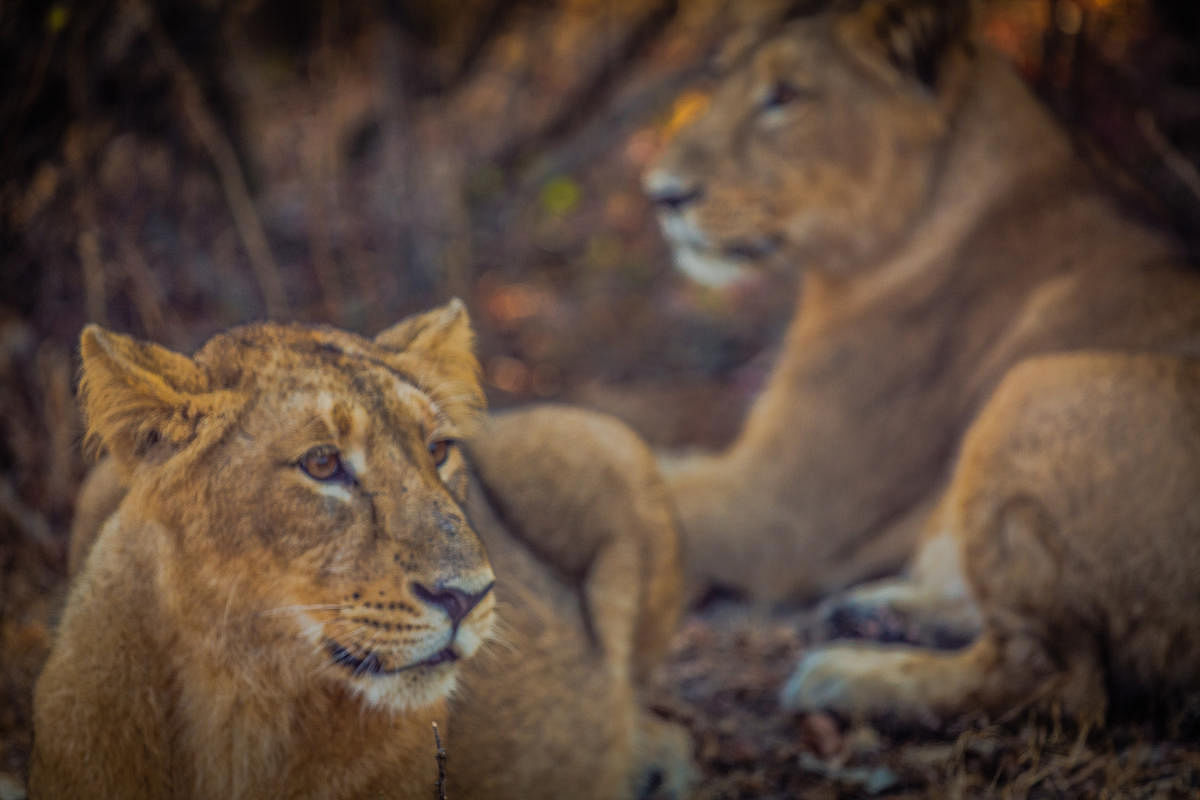
My husband had done the unthinkable: he was having a loud, hearty conversation while we were praying hard for the sighting of a lion in Gir Forest National Park. He was in the midst of comparing our present wait to the endless wait for a couple at their wedding reception when all of a sudden he stopped mid-sentence; five majestic lions had just sauntered into our view. The five beauties walked practically one behind the other, and two of them settled comfortably right under the shade of a nearby shrub, stretching their limbs and licking their whiskers cat-like. This unbelievable sight was at Sasan Gir Sanctuary, the last refuge of Asiatic lions.
Meeting the big cats
Surprisingly, centuries ago, lions roamed all across Asia and parts of Europe and Africa. Over centuries, with their habitat shrinking, Asiatic lions are now found only in Southern Gujarat and their African cousins in Eastern and Southern Africa. The Asian lion is physically different from its African cousin, being smaller in size and with a smaller mane. The Asian lion has an additional distinctive fold of skin in its underbelly. Socially, the two are different, with a pride of Asian lions consisting of small female groups, generally siblings, and their cubs, with males joining in during the mating season only. The African lion forms bigger prides, consisting of two to three males, 10-12 females, and a large number of cubs.
We were travelling by road, having planned a 20-day trip around Gujarat, and we drove into Sasan Gir from the beautiful Palitana. On reaching our resort, we grabbed an early dinner and headed to bed as soon as possible. The next day, we headed out early so that we could be at the ticket counter by 5 am. After a fair amount of documentation, our safari got going, and by 5.30 am, the first jeeps had entered the sanctuary.
Gir Lion sanctuary is one of the first national parks established in India and is considered to be an important protected area in Asia. It was the hunting ground of the Nawabs of Junagadh, who were trophy hunters. This practice actually resulted in a drastic drop in the lion population here; apparently in 1913, the lion count had plummeted to only 20, close to the brink of extinction.
Over the years, with the efforts of the government, various agencies, NGOs and wildlife conservationists, the count of lions at Gir has grown exponentially. In 2015, the lion count was recorded at 523. Apart from the conservation efforts, moving the semi-nomadic Maldhari tribe out of the Gir core forest also helped the cause. Interestingly, the lion census here is done by the ‘Cat Women of Gir Forest’. There are 40 women van raksha sahayaks from the traditional tribes, and it is said that the lions are almost tame in the presence of these guards.
This is a dry deciduous forest, with small shrubs and grasslands, and is an ideal environment for the lions. Apart from lions, there are 2,375 different fauna species in Gir, including 38 species of mammals; the most feared being the leopard and the striped hyena. More than 300 bird species have made Gir their home. And Gir has more than 400 plant species, mainly teak, acacia and grassland.
We entered the core zone just before 6 am. Once there, the driver and guide were on the lookout for various clues like fresh pugmarks, calls of other animals and birds, and the last lion sighting spot. With these bits of information, they zeroed on the most likely sighting spot. Soon we crossed a streamlet, with green vegetation on either side, and continued on the dusty road deeper into the forest, endlessly looking for the prize — a lion. But with time, feeling very low, apart from herds of deer and an occasional monkey, we had seen no other fauna. An occasional jeep would raise our hopes, with tidbits shared on the sighting of fresh pugmarks, but nothing beyond that.
Hours passed and we were resigned to enjoying the dusty ride and the dry forest when the next jeep shared the sighting of a lion and our jeep dashed towards the area. The spot was a no-brainer, as dozens of jeeps were already waiting in the vicinity. Gradually, from anticipatory silence, the volume of chatter grew to sheer cacophony with all visitors chatting away.
Lucky sightings
In fact, we waited a long, long time, with other jeeps just giving up and ultimately, we were the only waiting jeep. Soon, five lions sauntered into our vicinity, all in a straight line, and two sat down at no more than 20 feet from us. In fact, the two were soon busy polishing their whiskers, not bothered by our presence. The excitement amongst us was so palpable, it could almost be heard!
These majestic creatures have adapted to their environment totally, making it difficult to spot them on the move. In fact, thanks to their colouring, it’s close to impossible to spot them at a glance, so we were blessed to spot them at an area with short or no grass. The two lions that settled close to our jeep continued to stretch and relax so much so that I could change the lens on my camera and take a zillion pictures, and they continued to entertain us with their kitten-like gestures. And after a good long time, our guide and driver had to coax us into leaving, with the two lions continuing to enjoy their nap under the shade of the shrub.
We were the toast of our resort. The rest of our group was practically in tears on hearing about our unbelievable luck, and more so on seeing our amazing pictures. At the evening campfire, dozens of tourists stopped by to see our pictures and hear our story, and most of them were ready to try their luck again with yet another safari.